M. Mathew1, Saji. P1, Raza Mohamed1, P. Sesha. Reddy1, Acu. Varma2 and Ashish R.Jain3
1Department of Prosthodontics, Pariyaram dental college, Pariyaram, Kannur(Dt), kerala, India.
2Department of Prosthodontics, Goverment Dental College, RIMS, Putlampali, Kadapa, India.
3Department of Prosthodontics, Saveetha Dental College and Hospitals,Chennai, India.
Corresponding author E-mail: dr.ashishjain_r@yahoo.com
DOI : https://dx.doi.org/10.13005/bpj/1119
Abstract
Recent studies have shown that plasma treatment of impression surfaces improve the surface wettability of the material, it was decided to explore whether the Radio-frequency glow discharge process is useful in improving the wettability of impression materials.To compare the effect of RGD on the improvement of wettability of the surface of the elastromeric impression materials with a topical surfactant, applied over the same elastomers. 24 specimens of elastomers discs of 30mm diameter and 3mm thickness were prepared. 12 specimens were exposed to commercial surfactant an remaining 12 specimens were subjected to RGD exposure and were grouped as Group A- Addition silicone, Group B- Condensation silicone, Group C- Polyether. Addition silicone showed a mean contact angle of 53.4 before exposure and on exposure to RGD dropped to 44.3 and 39.7 on exposure to surfactant showing a decrease in contact angle for both. Condensation silicone showed a mean contact angle of 47.8 before exposure and on exposure to RGD dropped to 21.4 and 37.6 on exposure to surfactant.. Polyether showed a mean contact angle of 44.8 before exposure to RGD and surfactant and on exposure to RGD dropped to 43.4 and 16.3 on exposure to surfactant. Within limitations of the study, the contact angle values were decreased for all the three materials tested namely, addition silicone, condensation silicone and polyether, after application of topical surfactant and after exposure to Radio-frequency glow discharge.
Keywords
Contact Angle; Elastomers; RGD; Surfactant; Wettability
Download this article as:| Copy the following to cite this article: Mathew K. M, Saji P, Mohamed R, Reddy P. S, Jain A. R, Varma A. A Comparative Evaluation of Contact Angle Changes on three Topical Surfactant Application and Exposure to Radio-Frequency Glow Discharge. Biomed Pharmacol J 2017;10(1). |
| Copy the following to cite this URL: Mathew K. M, Saji P, Mohamed R, Reddy P. S, Jain A. R, Varma A. A Comparative Evaluation of Contact Angle Changes on three Topical Surfactant Application and Exposure to Radio-Frequency Glow Discharge. Biomed Pharmacol J 2017;10(1). Available from: http://biomedpharmajournal.org/?p=13786 |
Introduction
The construction of an acceptable fixed or removable prosthesis depends upon casts and dies having maximum accuracy. An accurate die must be a perfect positive replica of the prepared tooth. An important factor involved in making accurate casts or dies is the interaction of the gypsum slurry with the elastomeric impression material. When the mixed gypsum material i.e. die-stone, is poured into the impression, the resultant cast or die should be free from voids. To obtain such void-free casts, the gypsum slurry must sufficiently wet the surface of the impression material. The surface of an impression material can be adequately wetted by the mixed die-stone, only when it has a high surface energy1-3. Impression material that posses low surface energy, exhibit decreased wettability with the gypsum material and this is a general problem with elastomers (Chai & Young)4. When a stone cast is poured, bubbles can become trapped in the small margins and retentive grooves as a result of the hydrophobic nature of the surface of the impression material. To avoid this problem, several solutions have been introduced 5-9.
Intrinsic incorporation of surfactants during manufacture,
Pre-wetting the surface with a topical surfactant to improve wettability,
Treating with RGD (i.e. Radio-frequency-Glow-Discharge).
Adding surfactants to the base composition of elastomers was introduced to improve wettability of hydrophobic material, especially polyvinyl silloxane. This addition proved successful in increasing the wettability of some hydrophobic impression materials but only to a relative degree10-12. McCormick et.al (1989) in a study showed that topical surfactant could be used to enhance the wettability of elastomers.13 Barry K. Norling and Morris H.Reisbick (1979) evaluated the effect of surfactants on elastomers and side it increases the wettability14. Nevertheless, they were of the opinion that the choice of the most effective surfactant is critical and differs not only between types of elastomers, but also between brands of a single type.2 Fernandes and vassilakos (1993) evaluated the effect of plasma treatment on silicone elastomers and concluded that detail reproduction was superior in casts produced from impression which were plasma treated.9 Radio-Frequency-Glow Discharge (RGD) produces a high-energy surface on a material and thereby improves surface wettability (Vassillakos – 1993). It produces a plasma gas in a glass chamber. Plasma is a partially ionized complex gas composed of electrons, ions, free radicals, photons of various energies and gas atoms in both ground state and higher excited states15-19. The glow discharge process produces an energized gas flow that modifies the physic-chemical characteristics of solid surfaces without affecting the underlying bulk properties of the material. Recent studies have shown that plasma treatment of impression surfaces can improve the surface wettability of the material. Since coating with surfactants has limitations and the plasma exposure for the elastomers is a new concept, it was decided to explore whether the Radio-frequency glow discharge process is useful in improving the wettability of impression materials 20-26. Hence the present study has been undertaken to compare the effect of RGD on the improvement of wettability of the surface of the elastromeric impression materials with a topical surfactant, applied over the same elastomers. Objectives of this study were the following:
To find out the contact angles of three different elastomeric impression materials namely: Addition silicone, Condensation silicone, Polyether
To find out the effect of topical surfactant application on the contact angles of the three different elastomers.
To find out the effect Radio-frequency glow discharge exposure on the contact angles of the three different elastomers.
To comparatively analyse the respective changes in contact angle values among the three elastomers when topical surfactant is applied over them.
To find out comparatively the respective changes in contact angle values among the three different elastomers, when they were exposed to RGD.
To find out comparatively, the corresponding changes in contact angles (improvement in wettability) caused by surfactant application and RGD exposure.
To determine whether RGD exposure has the ability to increase wettability of elastomers.
Materials and Methods
This study was done to evaluate the improvement in wettability of the surface of an impression material by using radio frequency glow discharge in comparison with a topical surfactant.
Fabrications of A Master Die for Samples for Contact Angle
A square stainless steel die having a circular depression in the center was used to yield specimens 30mm in diameter and 3mm in thickness (Fig 1).
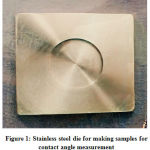 |
Figure 1: Stainless steel die for making samples for contact angle measurement |
Procedure for Preparing Samples
24 specimens of elastomers discs of 30mm diameter and 3mm thickness were prepared. 12 specimens were exposed to commercial surfactant an remaining 12 specimens were subjected to RGD exposure. For measuring the contact angle, a stainless steel-die with a central circular master die was used to prepare the samples. Impression material was mixed according to the manufacturer’s instructions and placed in the stainless steel die and allowed to set. To make the external surface of the samples even and smooth, a planar glass slab cleaned with ethanol was used to compress the impression material in the die. After the impression material had set, the glass slab was removed and the samples were retrieved. Samples for the study were grouped as follows: Group A- Addition silicone (3M expressTM, 3M Dental Products, light body), Group B- Condensation silicone (Speedex Light body, Coltene, medium body), Group C- Polyether (Impregum F, ESPE). Eight samples from each group were tested for contact angles first, before exposure to RGD and application of surfactants. Eight samples from each group were divided into two categories (Fig 2). Each category contained four samples. First category of samples (4 Nos) was subjected to RGD (100W RGD Device (E306A, Edwards High Vacuum Ltd., Crawley, Sussex, U.K.) and each category of sample were designated as: A1- Addition silicone, B1- Condensation silicone, C1- Polyether. Second category of samples (4 Nos) was subjected to application of topical surfactant (Silikon & Wachs) an each category of sample were designated as: A2- Addition silicone, B2- Condensation silicone, C2- Polyether. Application of silicon and surfactant was done by spraying and ensuring that the surfaces of the samples were evenly coated. (Fig 3).
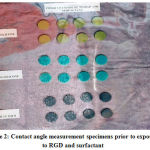 |
Figure 2: Contact angle measurement specimens prior to exposure to RGD and surfactant
|
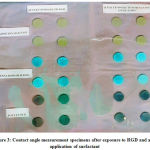 |
Figure 3: Contact angle measurement specimens after exposure to RGD and after application of surfactant
|
Table 1
| Material | Group A | Group B | Group C |
| Prior to Exposure to RGD and Topical Surfactant | 8 samples | 8 samples | 8 samples |
| Exposure to RGD | A1 (4 Samples) | B1 (4 Samples) | C1 (4 Samples) |
| Exposure to Topical Surfactant | A2 (4 Samples) | B2 (4 Samples) | C2 (4 Samples) |
Process of Measuring Contact Angles
First optimization was done by exposing few samples from each group to RGD at various times (10 sec, 30 sec, 1 min, 3 min, 5 min) to find out the most favorable time that could improve the wettability of that particular impression material on exposure, without affecting its surface properties. For measuring contact angle, 5 µl droplet of distilled water was used. The droplet was placed on the sample surface using a micropipette. Here also optimization was done to find out the favorable time when contact angle could be measured precisely. The contact angles were read (0 Sec, 10 Sec, 1 min, 3 min) after placement of the droplet on the sample. After the contact angles were measured, the improvement in wettability of the materials was found out by comparing the pre-exposure measurement and post-exposure measurement (ie. exposure to RGD and topical surfactant). The improvement in wettability by RGD was compared with the improvement in wettability by topical surfactant to find out by which method the wettability of the above materials could be improved more.
Statistical Analysis
Mean and standard deviation were estimated from the sample for each study group. Mean values were compared by one – way ANOVA. Multiple range test by Tukey – HSD procedure was employed to identify the significant groups at 5% level. Comparison of mean change within the group was compared by Student’s Paired t – test, P<0.05 was considered as the level significance.
Results
Addition silicone showed a mean contact angle of 53.4 before exposure and on exposure to RGD dropped to 44.3 and 39.7 on exposure to surfactant showing a decrease in contact angle for both. Condensation silicone showed a mean contact angle of 47.8 before exposure and on exposure to RGD dropped to 21.4 and 37.6 on exposure to surfactant. Here condensation silicone showed a marked decrease in contact angle after exposure to RGD. Polyether showed a mean contact angle of 44.8 before exposure to RGD and surfactant and on exposure to RGD dropped to 43.4 and 16.3 on exposure to surfactant. Here polyether showed more affinity to surfactant in reduction of contact angle that when exposed to RGD. Polyether when exposed to RGD showed only a slight drop from 44.8 to 43.4 showing slight decrease in contact angle (Graph 1-3). From the above results obtained, it was inferred that RGD produced marked improvement in wettability for condensation silicone. Surfactant application only improved the wettability of polyether. As far as addition silicone was concerned, RGD exposure did not result in considerable decrease in contact angle, but surfactant application reduced it more (Graph 4).
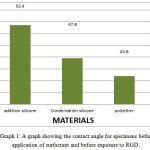 |
Graph 1: A graph showing the contact angle for specimens before application of surfactant and before exposure to RGD.
|
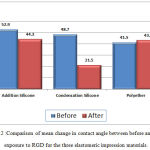 |
Graph 2 :Comparison of mean change in contact angle between before and after exposure to RGD for the three elastomeric impression materials.
|
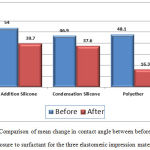 |
Graph 3: Comparison of mean change in contact angle between before and after exposure to surfactant for the three elastomeric impression materials
|
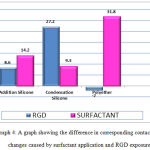 |
Graph 4: A graph showing the difference in corresponding contact angle changes caused by surfactant application and RGD exposure
|
Discussion
Production of well fitting cast restorations demands that a high degree of accuracy be maintained from the impression to the final restorative procedure. During the fabrication of prosthesis, many steps are involved. Impression making and the cast pouring stages, to a great extant, are the foundation for subsequent procedures. An impression material must sufficiently wet the tooth structure and soft tissues without developing voids on the surface of the impression itself. The intimate contact of the fitting surface of a cast restoration with the prepared tooth structure in the patient’s mouth is dependent upon an accurate cast. Such a cast must be obtained from an impression that registers the tissue details accurately. Impression details and subsequent positive reproduction in the cast are influenced by many factors, foremost among them being wettability and flow. The extent to which an impression material replicates the structures of the oral cavity depends on, among other variables, its compatibility with gypsum die stone. Besides being dimensionally and chemically stable in the presence of gypsum, an impression material should possess surface properties that allow it to be wetted by a standard mix of gypsum. Inadequate wetting of an impression results in the incorporation of air bubbles and voids in stone casts27-30. Polyvinyl siloxane impression materials are widely used in dentistry. Inspite being expensive, they are used in many treatment modalities. Their main advantages are good dimensional stability, availability in a range of viscosity to suit various clinical situations, ability to be sterilized by immersion in disinfectants and relative ease of use. Their disadvantages include difficulty in controlling working time and high surface tension. The letter gives rise to poor recording of details in moist conditions, as well as an increased risk o voids in dies poured from the impression. Surface tension is the contractile force within the liquid that causes the formation of drops and resists spreading over a solid surface. Wetting of a surface is the degree of spread of a drop over the solid surface. The wetting of surface can be improved by the use of a surfactant, a surface active agent or a wetting agent. The advancing contact angle is a measure of the wettability of a surface by a particular liquid. The greater the angle, the greater the risk of entrapment of air on the surface may result in voids in impression or dies. Wetting the surface impressions by die stone is important because, the contact angle of water placed on the impression material has been shown to be related to the number of bubbles formed in the dies poured from the material.
To overcome the problems associated with the hydrophobic nature of these impression materials, manufacturers have made hydrophilic variants. Non hydrophilic poly- vinyl siloxane impression materials are less wettable than hydrophilic polyvinyl siloxane and polyether materials. Although hydrophilic elastomers containing a surfactant wet a surface adequately, Panichtra et al., have shown them to be slightly less dimensionally accurate than hydrophobic polyvinyl siloxanes. They reported that topical surfactants were more effective than intrinsic surfactants.18 Results among other investigators have been variable. Selection of a topical surfactant is critical from one brand to another even in a single type of impression material itself. McCormick et al. have reported that topical surfactant decreases the surface strength of gypsum.13
Contact angle is the angle formed between the surface of the wetted solid and a line tangent to the curved surface of the drop of a liquid at the point of three phase contact. When water is the contracting liquid, solids with contact angles less than 90o are called hydrophilic and solids with contact angles more than 90o are called hydrophobic. Contact angles of liquids on impression materials have been measured by many investigators using water, gypsum and aqueous solutions of CaSO4 was not used and water was used. Since the contact angels for addition silicone and condensation silicone have been reported to be greater than 90o, both are considered hydrophobic. The present study revealed that the polyether specimens had the lowest mean contact angle value prior to exposure to RGD and before application of topical surfactant. This is in agreement with the work of Loren et al. Contact angle values after applications of topical surfactant and after RGD exposure were lower for all three elastomers. Reduction in contact angle values after application of topical surfactant was the greatest for polyether followed by addition silicone and then condensation silicone. Thus in the present study topical surfactant seemed to increase the wettability of polyether considerably. RGD exposure drastically decrease the contact angle values for condensation silicone specimens for more than 50% suggesting considerable increase in wettability for condensation silicone. Addition silicone and polyether materials also exhibited a decrease in contact angle after exposure to RGD, but to a lesser value. Among the three impression materials, condensation silicone, specimens showed more than 50% improved wettability. The present study reveals that RGD process is a useful technique to improve the wettability of impression materials. This Is in agreement with the study of Fernandez and Vassilakos et al.10 Wide variation in actual contact angle values reported by different investigators is the result of a number of factors related to sample preparation and the technique of measurement. Pratten and Craig recommended that surface energy measurement are best carried out in vacuum chambers.20 The advantages of RGD lies in its ability to extensively modify the surface properties of a polymer without affecting its bulk properties Yesuda et al30. It is a method proposed to enhance the wettability of impression materials that originally have a low surface energy. The generated species from the discharged process have enough energy to remove low molecular weight contaminants from the material’s surface and introduce polar groups at the outermost surface layers of the treated material. The present study suggests that RGD exposure increases the wettability of elastomers. This is evidenced by the reduction in contact angle values after exposure to RGD chamber, compared with values prior to exposure. Although topical surfactant is comparatively economical, its selection for a particular impression material is critical and variations due to handling differences could always arise. Standardization and uniformity of application are better when RGD is used. The RGD equipment requires a vacuum pump and the expansion of the biomaterials technology industry may also increase the use of glow discharge for conditioning surfaces which could improve the availability and cost benefit. Impression materials and techniques should be selected to their specific characteristics to perform a specific task. The plasma treatment technique (RGD exposure) could, as the present study suggests, provide a method that improves the wettebility of commonly used impression materials without changing other physical properties. Plasma treatment has a very short operating time (5min) and demands no special skills. With its use dentists do not necessarily have purchase newly developed materials exclusively for their improved wettabilty. Thus plasma treatment method i.e. Radio-frequency glow discharge method can substantially improve the wettability of elastomeric impression materials.
Conclusion
Within limitations of the study, the contact angle values were decreased for all the three materials tested namely, addition silicone, condensation silicone and polyether, after application of topical surfactant and after exposure to Radio-frequency glow discharge. Among the three elastomers polyether showed greatest decrease in contact angle after application of topical surfactant, condensation silicone showed the greatest degrease in contact angle after RGD exposure.
References
- Arronsson B.O, J.Lausmaa, B.Kasemo. Glow discharge plasma treatment for surface cleaning and modification of metallic biomaterials. J Biomedical Mat Res 1997; 35: 49-73.
- Barry K. Norling, Morris H. Reisbick. The effect of nonionic surfactants on bubble entrapment in elastomeric impression materials. J Prosthet Dent 1979; 42(3) : 342-347.
- Bochiechio R, McIntyre F, Sorensen S, Johnson R. Surface wetting of elastomeric impression material following Radio-frequency glow discharge. J Dent Res 1991; 70 :432, Abstr No. 1327
- Chai J.Y, Yeung T.C. Wettability of nonaqueous elastomeric impression materials. Int J Prostodont 1991; 4: 555-60.
- Chandra P. Sharma, P.R.Hari. Adhesion and stability of blood cells into polymer substrates: Effect of glow discharge. J Biomaterial Appl 1991; 6: 72-79.
- Chong Y.H, Soh g, Setchell D.j, Wickens J.L. The relationship between contact angles of die stone on elastomeric impression materials and voids in stone casts. Dental Materials 1990; 6:162-6.
- Cullen D.R, Mikesell J.W, Sandrik J.L.Wettability of elastomeric impression materials and voids in gypsum casts. J Prosthet Dent 1991; 66 : 261-5.
- Fernandes C.P, Vassilakos N, Nilner K. Surface properties and castability of elastomeric impression materials after plasma cleaning. Dental Materials 1992; 8 : 354-8.
- Fernandes C.P, Vassilakos N. Accuracy, detail reproduction and hardness of gypsum cast produced from silicone impressions treated with glow discharge. J Prosthet Dent 1993; 70:457-64.
- Fernandes C.P, Vassilakos N. Effect of plasma treatment on the wettability of elastomeric impression materials. J Prosthet Dent 1993; 70: 165-71.
- George J and C.P. Sharma. Platelet adhesion to surface treated with glow discharge and albumin. J Biomat Res 1986; 20: 677-82.
- Kess R.S, Combe E.C, Sparks B.S. Effect of surface treatment on the wettability of vinyl polysiloxane impression materials. J Prosthet Dent 2000; 894(1): 98-102.
- McCormick J.T, Antony S.J, Dial M.L, Duncanson M.G, Shillingburg H.T. Wettability of elastomeric impression materials: Effect of selected surfactants.Int j Prosthodont 1989; 2: 413-20.
- Millar B.J, Dunne S.M, Nesbit M. A comparison of three wetting agents used to facilitate the pouring of dies. J Prosthet Dent 1995; 74: 341-44.
- Norling B.K, Conn L.J. Wetting properties of hydrophilic and conventional polyvinyl siloxanes. J Dent Res 1988; 67:282, Abstract No.1353.
- Ozden Nehir, Hakan Ayhan, Selim Erkut, Gulsen Can, Erhan Piskin Coating of silicone-based impression materials in a glow – discharge system by acrylic acid plasma. Dental Materials 1997; 13(3):174-8.
- Pamela Herrera, Virginia A, Merchant. Dimensional stability of dental impressions after immersion disinfection. J Am Dent Assoc 1986; 113: 419-21.
- Panichuttra R, Jones R.M, Goodacre C, Munoz C.A, Moore B.K.Hydrophilic polyvinyl siloxane impression materials. Dimensional accuracy, wettability, and effect on gypsum hardness. Int J Prosthodont 1991; 4(3): 240-48.
- Paul J. Milward, Mark G, Waters. The effect of disinfection and a wetting agent on the wettability of addition polymerized silicone impression materials. J Prosthet Dent 2001; 86(2): 165-7.
- Pratten D.H, Craig R.G. Wettability of a hydrophilic addition silicone impression materials. J. Prosthet Dent 1989; 61(2) 197-202.
- Pratten D.H, Covey D.A, Sheates R.D. Effect of disinfectant solutions on the wettability of elastomeric impression materials.J Prosthet Dent 1990; 63: 223-7.
- Richard M. Hesby, Chris R. Haganman, Clark M. Effect of Radio-frequency glow discharge on impression material surface wettability. J Prosthet Dent 1997; 77(4): 414-22.
- Robinson P.B, Dunne S.M, Millar B.J. An in-vitro study of a surface wetting, agent for addition reaction silicone impressions. J Prosthet Dent 1994; 71(4): 390-3.
- Robinson P.B, Milar B.J, Dunne S.M. An in-vivo study of a clinical surfactant used with polyvinyl siloxane impression materials. Quintessence Int 1996; 27(10) 707-9.
- Robert A. Lorren, Douglar J. Satter, Carl W. Fairhurst. The contact angles of die stone on impression materials. J Prosthet Dent 19796; 36(2): 176-80.
- Vassilakos N and Fernandens C.P. Surface properties of elastomeric impression materials. J Dent 1993; 21(5) 297-301.
- Winston W.L, Chee and T.E. Donovan. Polyvinyl siloxane impression materials. A review of properties and techniques. J Prosthet dent 1992; 68: 728-32.
- Xavier Lepe, Glen. H. Johnson, John C. Berg. Surface characteristics of polyether and addition silicone impression materials after long-term disinfection. J Prosthet Dent 1998; 79(5) 495-501.
- Xavier Lepe, Glen. H. Johnson, John C. Berg, Tar.C. Aw. Effect of mixing technique on surface characteristics of impression materials. J Prosthet Dent 1998; 79(5) 495-501.
- H and M.Gazicki, Biomedical applications of plasma polymerization and plasma treatment of polymer surfaces. Biomaterials 1982; 3: 68-75.







